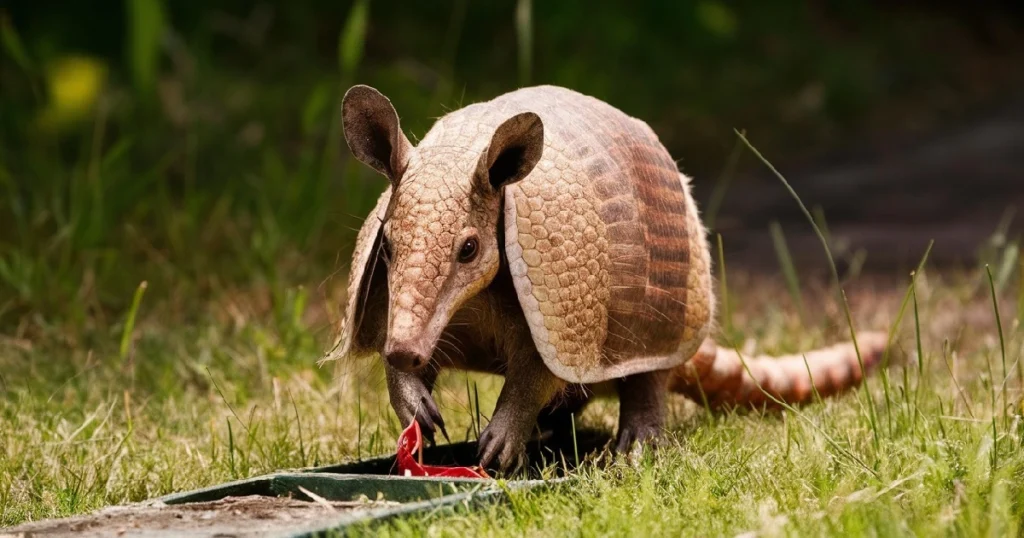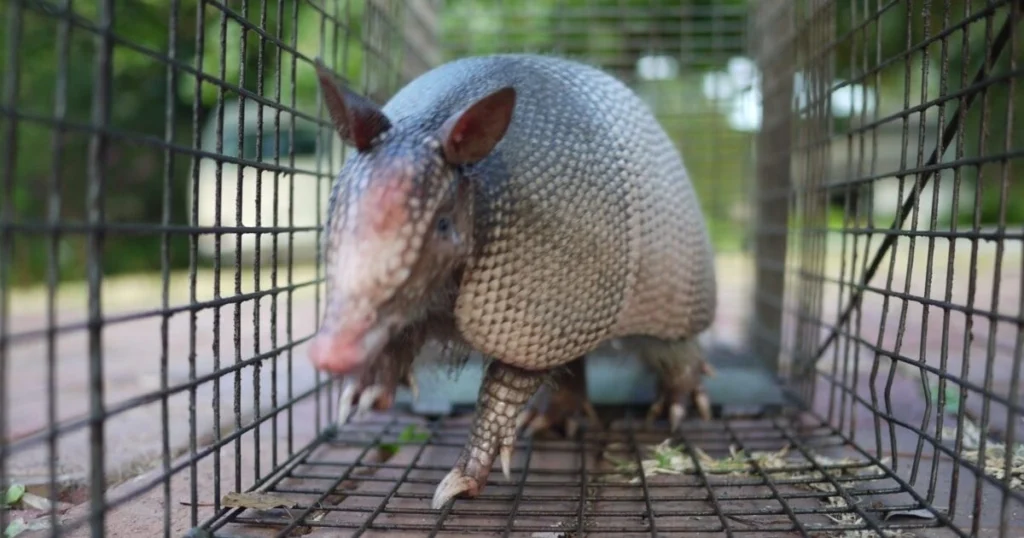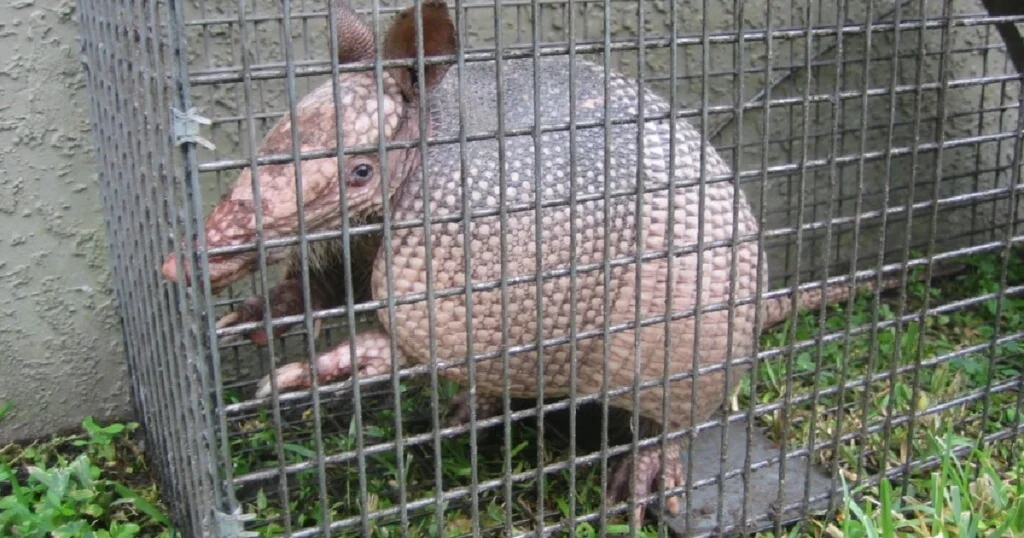
Armadillos are fascinating creatures that have become quite common in many parts of the world. Although they are known for their hard shells, these animals are not invincible, and they can cause significant damage to lawns and gardens. Fortunately, there are several ways to keep armadillos at bay, one of which is using armadillo bait.
Armadillo bait attracts these animals and lures them away from your property. While no specific bait consistently works, strategic placement and long wooden boards are vital to success. The bait is usually made from a combination of ingredients that are attractive to armadillos, such as insects, grubs, and other small animals. When placed in strategic locations, the bait can be an effective way to control armadillo populations and prevent them from causing damage to your green areas.
Finding the best armadillo bait can be a challenge, as different types of bait may work better in different situations. Some baits may be more effective in attracting armadillos, while others may be more effective in repelling them. Additionally, some baits may be more environmentally friendly than others, so choosing a safe bait for humans and animals is important. With the right armadillo bait and patience, you can keep these fascinating creatures at bay and protect your property from damage.

Armadillos are primarily found in the Americas, ranging from South America to the southern United States. These animals are known for their unique armor-like skin, which is made up of plates covering their entire body. Armadillo's behavior resembles moles. Armadillos are mainly nocturnal, so they are most active during the night. During the day, they usually burrow underground or find a shaded area to rest in.
Armadillos are known for their burrowing abilities, which they use to create their homes. They will dig burrows up to 25 feet long and 6 feet deep. These burrows are used for shelter, protection, and raising young. Armadillos are also known for their strong sense of smell, which they use primarily to locate food and avoid predators.
Armadillos are omnivores, eating plants and animals daily. Their diet consists of insects, grubs, worms, and small reptiles. They also eat fruits, berries, and other plant material. Armadillos have a unique feeding behavior: They use their sense of smell to locate food. Then, they use their sharp claws to dig and find their prey.
When baiting an armadillo trap, it is important to use food they naturally eat. This can include mealworms, crickets, and other insects. You can try more exotic options like dog food and fruits. Armadillos can be picky eaters, so finding the right bait for your trap may take trial and error.
In conclusion, understanding armadillos is important for trapping and baiting. Knowing these wild animals' natural habitat, behavior, and feeding habits can help increase the chances of successfully trapping an armadillo. Using the right bait and understanding their diet makes a huge difference in the success of your armadillo trapping efforts.

Live traps are a humane way to trap an armadillo without causing them harm. These traps work by luring the armadillo into the trap with bait and trapping it inside. There are several different types of live trap mechanisms, including:
Live traps are a humane way to capture armadillos without causing them harm. These traps work by luring the armadillo into the trap with bait and trapping it inside. There are several different types of live trap mechanisms, including:
When choosing a live trap mechanism, consider the size, strength, and type of bait that will be used to lure the armadillo into it.
The design and placement of the cage can also play a big role in the effectiveness of armadillo trapping. Some things to consider when choosing a cage include:
When placing the cage, it is important to ensure it is stable and secure. The cage should be placed on a level surface and anchored to the ground if necessary. Additionally, the bait used to lure the armadillo into the trap should be placed where it is easily visible and accessible to the armadillo.
Choosing the right armadillo trap and designing and placing it correctly can greatly increase the chances of successfully capturing an armadillo. By using the right bait and following these guidelines, homeowners can effectively and humanely remove armadillos from their property.

When choosing the right bait for an armadillo trap, it's important to consider the animal's natural food preferences. Armadillos are omnivores and feed on various insects, grubs, worms, and small animals. These creatures love fruits and vegetables, particularly melons and berries, and they don't mind rotting bananas.
Based on their natural preferences, some of the best bait options for armadillo traps include:
It's important to note that armadillos have a strong sense of smell, so using a bait with a strong odor can bring them to the trap.
There are two main options for bait for armadillo traps: natural and artificial. Natural bait refers to any natural bait, such as insects, worms, and fruits. Artificial bait, however, is any bait created specifically to trap armadillos.
While natural bait may seem the obvious choice, it's important to consider the potential drawbacks. Natural bait, such as raccoons or opossums, may attract other animals to the trap, making it difficult to catch the target armadillo. Additionally, natural bait may not be as effective as artificial bait in certain situations.
On the other hand, artificial bait is designed to attract armadillos and can be more effective at luring them into the trap. Some popular options for artificial armadillo bait include:
When choosing between natural and artificial bait, it's important to consider each option's specific situation and potential drawbacks. For example, if other animals in the area may be attracted to natural bait, it may be better to use an artificial option.
When choosing the right bait for an armadillo trap, consider the animal's natural food preferences and use a strong odor. Additionally, consider the potential drawbacks of both natural and artificial bait and choose the best option for the specific situation.

Preparing bait for an armadillo trap is a crucial step in trapping. The bait should be enticing enough to attract the armadillo to the trap. Various types of bait can be used to attract armadillos. Some popular options include earthworms, mealworms, fruits, and vegetables.
Before preparing the bait, it is important to identify the preferences of the armadillo in the area. This can be done by observing the feeding habits of armadillos in the vicinity. Once the preferences are identified, the bait can be prepared accordingly.
To prepare the bait, select fresh and ripe fruits and vegetables. Cut them into small pieces and mix them with earthworms or mealworms. This will create a tempting scent that will lure the armadillo towards the trap.
Once the bait is prepared, placing it in the right location is important to attract the armadillo to the trap. The bait should be placed in the trap's center, away from the walls. This will prevent the armadillo from accessing the bait without entering the trap.
We must ensure the bait is not visible from outside the trap. This will prevent other animals from accessing the bait and triggering the trap.
When placing the trap, it is important to consider the armadillo's natural path. Placing the trap in the armadillo's path will increase the chances of a successful catch.
In conclusion, preparing and using bait for an armadillo trap requires careful consideration of the armadillo's preferences and proper bait placement. Following these steps will improve the chances of successfully trapping an armadillo.

The success of trapping armadillos largely depends on the location and timing of the trap. Look for areas they are known to frequent, such as near the armadillo's burrow or where they have been seen digging for food. Armadillos get active at nighttime, so it is best to set the trap in the evening and check it early in the morning.
It is important to secure the trap properly to ensure the armadillo does not escape once caught. Place the trap on a flat, stable surface, and ensure it is level so the armadillo does not tip it over. Hide the bottom of the trap with leaves and dirt to make it look natural.
Regarding bait, armadillos are attracted to worms, insects, and grubs. Place these items in the trap to entice the armadillo to enter. Alternatively, you can use cat food or sardines as bait. Place the bait in the back of the trap so the armadillo has to step on the trigger to get to it.
Camouflage the trap by placing branches, leaves, and other natural materials around it. This will help to make the trap look like part of the environment, and it will be less likely to scare off the armadillo.
Overall, setting the trap properly is crucial to catching an armadillo. Following these tips and using the right bait can increase your chances of success.
Once the armadillo has been successfully captured, it is important to handle it with care. Armadillos have sharp claws and teeth and can carry diseases such as leprosy. You must wear gloves and protective gear when handling a caught armadillo.
The armadillo should be handled gently and released immediately if it is still alive. If it is injured or sick, it should be taken to a licensed wildlife rehabilitator for proper care.
Before relocating a caught armadillo, it is important to check local and state laws. In some areas, relocating armadillos without a permit may be illegal. Additionally, armadillos can be carriers of diseases and parasites, so it is important to avoid releasing them in areas where they may harm other animals or humans.
When relocating a caught armadillo, it is important to choose a suitable location. Armadillos are burrowing animals and require soft soil for digging. They prefer areas filled with insects and vegetation for food and shelter.
The best armadillo trap bait is recommended to increase the chances of successfully relocating a caught armadillo. Baits for armadillos can include mealworms, earthworms, and fruit such as cantaloupe or watermelon.
Armadillo capture and relocation can be safely and effectively accomplished by following proper handling techniques and considering legal and environmental factors.

Modifying their habitat is one of the best ways to prevent armadillos from invading your property. Armadillos prefer areas with loose soil, so keeping your lawn well-maintained is important. Mow your lawn and remove debris to make it less attractive to armadillos.
Another way to modify their habitat is to limit their access to water. Armadillos need water to survive, so removing any sources of water can help deter them from your property. Fixing any leaks or standing water can also help reduce the likelihood of armadillos inhabiting your property.
Exclusion techniques are another effective way to prevent armadillos from entering your property. Installing a fence on your property can keep armadillos out. The fence should be at least two feet deep and four feet tall. We must ensure the fence is buried underground to prevent armadillos from digging underneath it.
Another way to exclude armadillos is to seal off any potential entry points. Armadillos can fit through small openings, so it's important to seal off any gaps or holes in your home or other structures on your property.
When trapping armadillos, it's important to use the right bait. Armadillos are attracted to earthworms, grubs, and other insects. Using these as bait in a trap can increase the likelihood of capturing an armadillo.
Overall, making simple changes to your property can help prevent armadillos from invading. Modifying their habitat and using exclusion techniques can create a less attractive environment for armadillos.
If you're dealing with unwanted armadillos or pests on your property, it's time to call in the professionals at Critter Stop. As a leading humane wildlife removal company in North Texas, Critter Stop has provided top-notch services to homeowners and businesses for years. With a team of experienced and knowledgeable technicians, Critter Stop is the go-to solution for all your wildlife and pest removal needs.
Critter Stop has a fantastic reputation and online customer reviews because it provides high-quality work and great customer service. When you choose Critter Stop, you can trust that your armadillo or pest problem will be handled carefully and efficiently. Critter Stop will ensure your property is free from unwanted wildlife and pests from inspection to removal.
Don't let armadillos or pests wreak havoc on your property any longer. Call Critter Stop at (214) 234-2616 for a free inspection and take the first step towards a pest-free environment. With Critter Stop, you can rest easy knowing that your wildlife and pest problems are in good hands.
The best armadillo bait is strong-smelling and pungent, such as mealworms, earthworms, or rotten fruit. Armadillos have a keen sense of smell and are attracted to strong odors.
The best armadillo bait for trap is a bait that is strong-smelling and pungent, such as mealworms, earthworms, or rotten fruit. These baits will attract armadillos to the trap, making it easier to catch them.
You can bait an armadillo trap with earthworms, mealworms, or overripe fruit.
To create homemade bait for armadillos, you can use items such as mealworms, earthworms, or rotten fruit. Place these items in a small container and leave them near the trap.
Yes, armadillo bait can be used for a live trap. Using strong-smelling and pungent bait is important to attract the armadillo to the trap.
Armadillos are attracted to strong-smelling and pungent scents, such as mealworms, earthworms, or rotten fruit. These scents can be used to attract armadillos to traps.
The best bait to catch an armadillo is a bait that is strong-smelling and pungent, such as mealworms, earthworms, or rotten fruit. These baits will attract armadillos to the trap, making it easier to catch them.
The most effective methods for armadillo capture and relocation include using live traps and relocating the armadillos to a suitable habitat. Following local regulations and guidelines is important when capturing and relocating armadillos.
The best bait for an armadillo trap is strong-smelling and pungent bait, such as mealworms, earthworms, or rotten fruit. These baits attract armadillos to the trap, making it easier to catch them.
You can install fencing or barriers around your property to prevent armadillos from entering your property. You can also remove potential food sources, such as fallen fruit or garbage, that may attract armadillos.
Visit our Critter Library and learn more about our furry friends